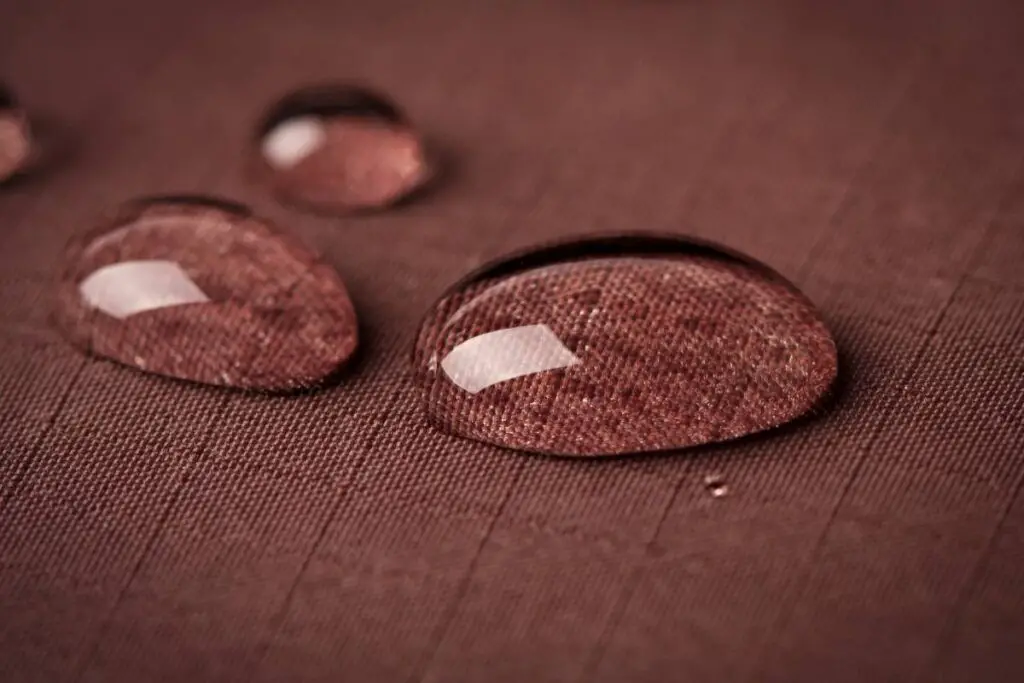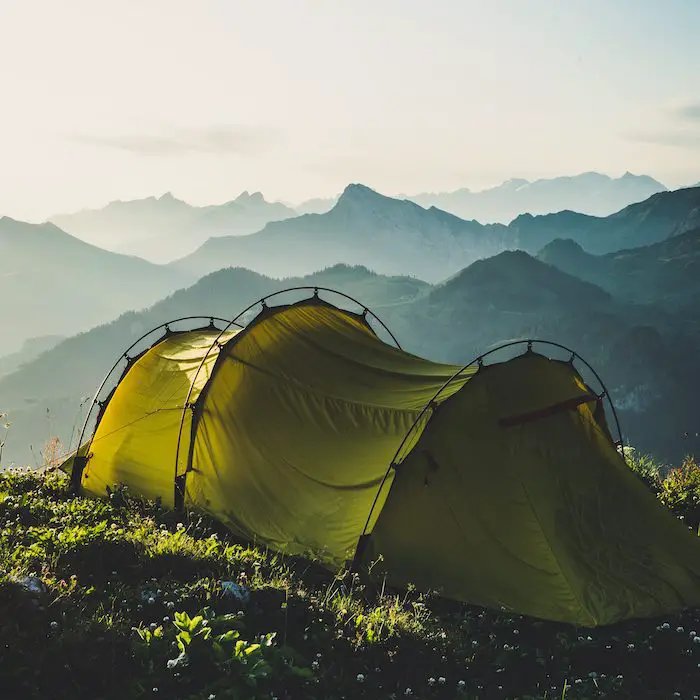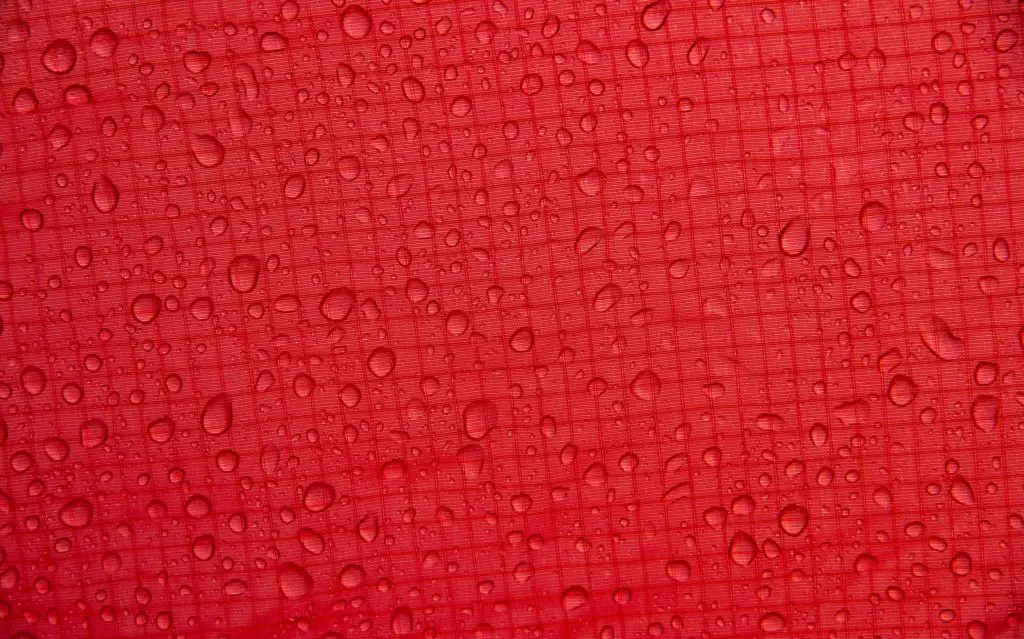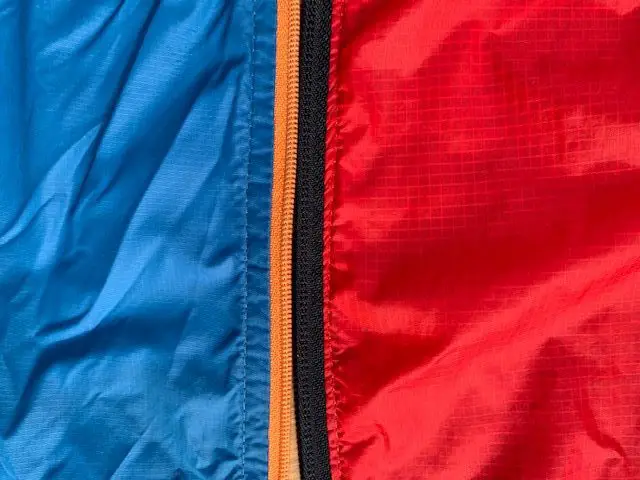Nylon is a synthetic fiber that has been used for decades in clothing and other products. It is durable, flexible, and strong – but is it fully waterproof?
Most nylon fabrics are considered water resistant but few are completely waterproof.
Nylon fabrics used for jackets, pants and bags will keep dry during a brief rain shower, but will eventually soak through. The thicker nylon material, the more water resistant it will be and if you apply a good waterproofing spray that can become virtually waterproof.
Nylon is made from polyamide (a polymer) and is used in a wide variety of products ranging from clothing, backpacks, sleeping bags and climbing rope. It has excellent strength properties and is highly durable for its weight.
Due to its nature as an oil-based plastic, it repels water, but some water does slip through the tiny holes between the threads in the weaved fabric.
Contents
Is Nylon Waterproof?
No, only the very thick nylons such as those tightly weaved with thread densities above 100D can be considered fully waterproof if also treated with a good water-repellant.
However, no nylon fabric is completely waterproof and even most nylon tent flysheets will eventually let some water through during heavy rain.
Most often waterproof nylon fabrics will be a blend of more than one polymer and typically a waterproof layer is applied on top.
Depending on how thick the nylon in question is, there will be some leakage of water through the fabric when the “hydrostatic pressure” reaches the breakpoint for that fabric.
Below is a table showing the approximate breakpoint hydrostatic pressure values for different nylon fabrics:
| Material | Grams/1000m thread | Avg. Fabric density | Water resistance (Hydrostatic Head) |
| 7D Nylon | 0.8 | 19 g/m² | 1000-2000mm |
| 10D Nylon | 1.1 | 25 g/m² | 1000-2000mm |
| 15D Nylon | 1.7 | 30 g/m² | 2000mm |
| 20D Nylon | 2.2 | 34 g/m² | 3000-4000mm |
| 30D Nylon | 3.3 | 47 g/m² | 4000-5000mm |
| 40D Nylon | 4.4 | 54 g/m² | 5000mmm |
| 210D Nylon | 23.3 | 70 g/m² | 15000mm |
| 400D | 44.4 | 100 g/m² | 20000mm |
Differences between the thinner nylon fabrics. The waterproof ratings are with appropriate treatments used in lightweight tents e.g. silicon.
Nylon can be made virtually waterproof if treated with a layer of silicon or PU (polyurethane) to make sure that no water gets through. This is often used in rain pants other rain gear.

However, for most use cases such as nylon sleeping bags, nylon backpacks or nylon for tents, the fabric is actually not completely waterproof.
Is 100% nylon water resistant?
Yes, most pure nylon fabrics are water resistant to some degree on their own. Some may be able to withstand a few drops and other, thicker fabrics, are able to withstand a moderate rain shower.
Some nylons are mixed with other fabrics to make them more waterproof or more breathable, but it is not usually needed for some degree of water resistance in nylon.
Most commonly, some surface treatment has been applied to make the fabric more water and dirt-repellant without compromising its breathability and strength.
What is the difference between water resistant and waterproof?
Waterproofing is a property of materials that prevents moisture from passing through them. This means that when water hits a surface, it will not penetrate the material at all.
However, some materials are more effective at preventing water penetration than others and those that will eventually allow some water to come through are termed “water resistant” rather than waterproof.
Waterproof fabrics will keep out water, while water resistant fabrics will allow some moisture to pass through.
In essence, if you wear a pair of pants made with a water-resistant fabric, you should avoid getting them wet for longer periods of time, whereas if you wear a pair of rain pants made with a water resistant fabric, you should not worry about getting them wet.
Why is nylon water resistant?
Nylon is naturally water repellant as it is made using a hydrophobic polymer. The nylon threads themselves are waterproof, but the fabric will not be completely waterproof on its own.
It is basically a plastic and the only way water can slip through is because nylon fabric has small openings between the threads used to weave it.

This is not just a bad thing, as it also allows the nylon fabric to stretch and breathe!
So whereas you are, in most cases, able to make a denser more water resistant nylon fabric, you will do so at the expense of flexibility and breathability.
This is why most nylons are “just” water resistant and not fully waterproof. It is done on purpose to ensure its breathability and to optimize its comfort.
Does nylon keep warm when wet?
Because nylon absorbs quite a bit of water when it rains, it will not be as warm as for example polyester when wet.
Nylon that has not been treated with any waterproofing agent will generally stay cold and wet for longer when wet and it will feel colder because the water actually goes through the fabric unless treated with an effective water-repellant.
Wet Nylon Becomes More Water Resistant!
Water can pass through untreated nylon fabric. But did you know that it will actually do so to a lesser degree as soon as the first amount of water is absorbed?
Why is that?
Nylon is, compared to for example polyester, much more willing to absorb moisture and will also expand in the process (that is why your tent sacks in rain!).

Nylon has a tendency to absorb water and a backpack with untreated nylon will therefore slowly absorb water when it rains. Because the water also makes the nylon threads expand, the fabric actually gets tighter when wet and will therefore increase its water resistance the wetter it gets!
Sounds confusing?
Let me explain: If you have thin nylon threads in a loosely woven fabric, this fabric will be less water-resistant than thicker threads in a tightly woven fabric.
But as nylon gets wet, it absorbs the water into its fibers that expand as a result (an ability not seen to the same degree in polyester fabrics).
Therefore, as the nylon fibers absorb water, the threads get bigger to close off the small gaps between them, which results in a tighter and more water-resistant fabric!
This is a nice feature of nylon, which makes thick nylon fabrics almost entirely waterproof – especially if treated with water repellants as an initial barrier!
Is Ripstop Nylon Waterproof?
Ripstop (rip stop or rip-stop) nylon is the most common nylon material used as it is stronger than ordinary nylon fabric.
Ripstop nylon is a nylon fabric with interwoven reinforcement threads in a crosshatch pattern. It is used in products where durability is important, such as tents, sleeping pads, backpacks, and parachutes.
Ordinary nylon fabric does not have reinforcing threads and is not as durable.

These days, almost all nylon fabrics for outdoor gear are of the ripstop type as they are much stronger in terms of tear and abrasion resistance.
While ripstop nylon is stronger than ordinary nylon, the ripstop technology does nothing to make the nylon fabric more waterproof.
What makes nylon waterproof has to do with the thickness and tightness of weaving, rather than the strength of the fabric as such.
The same is the case for the thicker polyester fabrics that are also used for backpacks.
Can you waterproof nylon?
Most nylon fabrics can be waterproofed completely by fusing a waterproof material to the surface of the fabric.
This is however, only done well by large manufacturers and is not easy to do at home.
Thicker backpacks, however, can become virtually waterproof if you apply a hydrophopic material to the surface.
For example, the Scandinavian brand Fjällräven has used a type of wax called Greenland Wax that anyone can apply to waterproof their clothing or backpack at home.
Other similar products exist in the US, e.g. the Otter Wax which is pretty much exactly the same thing!
However it requires that you can heat the fabric enough to melt the wax, so it will not work for the thinner nylon fabrics!
For the thicker nylon fabrics, e.g. 100D and above (typically used for hiking pants and backpacks), you can carefully apply a thin layer of wax to make them completely waterproof.
However, waterproofing your nylon garment will come at the trade-off of losing some breathability!
Therefore, the best way to keep your nylon clothes dry is to avoid getting them very wet in the first place.
Can you use waterproofing spray on nylon?
Yes, you can apply a waterproofing spray to nylon clothing or a nylon bag to make them more water-repellent, but it will not make nylon completely waterproof.
These sprays are available at most hardware stores and sporting goods retailers. Whereas waterproofing

Waterproofing sprays will work with most types of nylon. However, if you are unsure whether your particular brand of nylon is treated with a waterproofing agent, contact the manufacturer directly.
Ideally, the spray should be applied before you put on the garment as dirt or pilling on the surface will prevent the waterproofing spray from sticking to the nylon surface.
Once you have sprayed the item, let it dry completely before wearing it. Do not wear the item until it has dried completely as the spray will come off.
Waterproofing sprays are designed to protect clothing against moisture, but cannot prevent the water from going through during prolonged exposure.
They work by creating a barrier between the outside air and the inside material. This prevents liquid from sticking to the garment and finding its way through the tiny holes in the fabric structures.
The same type of DWR products can be applied as a detergent using a washing machine.
However, these products are not perfect, and will wear off rather quickly over time and will need to be reapplied periodically.
How does nylon compare to polyester’s water resistance?
While nylon is a great material for outdoor and rain gear, polyester is another similar synthetic fabric that is also really worth considering if you are looking for something light and water-resistant!
Both materials are widely used for raincoats and are also integrated in many membrane technologies like Gore-Tex.
Polyester is the more water-resistant of the two, and it does not absorb water to the extent that nylon does.
But when adding surface treatments like DWR of silicon, and considering the extra thickness of most polyester pants and jackets, nylon can be almost as waterproof and is lighter and more breathable.
It really depends on the type of nylon used as some of the thicker versions above 20D but rarely thicker than 70-600D treated with silicon are perfectly capable of resisting a whole day of rain. This is why nylon is the preferred material for lightweight tents.

For clothing, however, the material needs to be more washable and friction proof so not all waterproof treatments are useable.
A huge downside of nylon when it comes to water is also that it will absorb a few percent of the water that lands on it.
This will make nylon heavier, colder, and less breathable compared to polyester when exposed to rain.
However, the exact extent to which each material is waterproof comes down to the type and amount of substance used to treat the fabric in the end.
Nylon is great for the more lightweight applications where the price is less of an issue. It will be less prone to dirt accumulation and more resistant to tears, which will usually make nylon rain jackets last longer.
It is also softer and many people find it more comfortable to wear.

Nylon is often used in lightweight and packable cycling or hiking jackets because less material is needed compared to a polyester jacket with similar functionalities.
Nylon is much stronger but repeated packing and unpacking does cause slightly more wrinkles in the jacket compared to polyester jackets (sew my photo above!).
Polyester is considered more breathable, somewhat more durable, and will last longer in the sun compared to nylon. However, polyester is also colder to wear compared to nylon of the same thickness.
These are nice features if you plan to use your raingear a lot in more sunny climates or just for everyday jackets that are worn a lot.
So the choice of material basically comes down to your preference for weight, price, and durability: If a lightweight, packable, rain jacket is important to you, choose a jacket predominantly made from nylon.
If weight is less of an issue and the jacket will be worn a lot but not packed down, choose polyester.
Will Nylon or Polyester Dry Faster When Wet?
Because polyester does not absorb the same amount of water when exposed to rain as nylon does, it will also dry faster.
Whereas it takes a nylon rain jacket four to six hours to dry under average conditions, it takes an average polyester rain jacket only around 3 hours to dry completely after a heavy rain shower!
Whereas nylon keeps the water embedded in between its thread fibers, polyester repels it more easily which helps it dry faster.
This is also what makes polyester more breathable and less warm to wear.
This is also an important consideration when choosing the fly sheet material for a tent for hiking if you want to avoid having a wet moldy tent laying all day in your backpack!
FAQs
Does nylon get ruined when wet?
No, nylon does not get ruined when wet. It is a synthetic material that is known for its durability and resistance to moisture. However, frequent or prolonged exposure to water can eventually cause it to weaken over time.
Does heat damage nylon?
Yes, heat can damage nylon. Exposure to high temperatures can cause nylon to melt, shrink, or deform. It can also cause discoloration and reduce the material’s overall strength and durability.
What happens to nylon when it gets wet?
When nylon gets wet, it absorbs a small amount of water, but it also dries quickly because it is a synthetic material. The absorption of water can make the nylon heavier and can slightly lower its strength and stiffness. However, these changes are usually minimal and may not significantly affect the overall performance of the nylon.
Is nylon naturally water resistant?
Yes, nylon is naturally water resistant due to its synthetic nature. It has the ability to repel water and dry quickly.
Can I wear nylon in the water?
Yes, you can wear nylon in the water. Nylon is a synthetic material that is known for its ability to dry quickly and resist water. It is often used in swimwear, outdoor gear, and water sports equipment.
How does nylon deteriorate?
Nylon deteriorates primarily due to prolonged exposure to sunlight, heat, and environmental conditions. Ultraviolet (UV) radiation from the sun can cause it to discolor, lose strength, and eventually break. Heat can cause it to melt or become brittle. Environmental conditions like high humidity or exposure to certain chemicals can also cause it to degrade. Additionally, physical wear and tear over time can cause nylon to fray and weaken.
What can damage nylon?
Nylon can be damaged by high temperatures, prolonged exposure to sunlight, strong acids and bases, bleach, and abrasive materials. It can also be damaged by certain insects and mold.
Is nylon sensitive to heat?
Yes, nylon is sensitive to heat. It begins to soften around 180-220°C and melts around 220-250°C. Prolonged exposure to heat can cause deformation, discoloration, and loss of mechanical properties.
Is nylon strong when wet?
Yes, nylon retains its strength when wet. In fact, it becomes even stronger when wet. However, prolonged exposure to water can eventually cause it to weaken.
Can you put nylon in water?
Yes, you can put nylon in water. Nylon is a synthetic material that is water-resistant and it does not absorb water easily, making it suitable for use in water.
Conclusion
Nylon fabrics are usually water resistant rather than waterproof, and if not treated with a waterproofing spray, they will allow some moisture to pass through even during shorter rain exposures.
Nylon itself is hydrophobic, meaning that it does not absorb water easily, but nylon fabrics has little holes in it due to its weave that lets water pass.
However, this is also what makes them breathable, so it is often a good thing!
Waterproofing nylon involves applying some sort of coating that prevents the fabric from letting any moisture through at all.
Some cloths have this as part of the manufacturing process (usually called DWR), but most don’t and need an aftermarket coating which may or may not actually work for long.
If you want to know more about water resistant fabrics and how to waterproof your gear, check out my recent posts:
How polyester compares to nylon when used in rain gear.
The differences between polyester and nylon tents and that used to make backpacks waterproof.
More about the thin nylon fabrics and those thicker ones used for backpacks and rain gear.
And what makes Fjällrävens products special when it comes to waterproofing?






